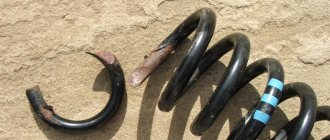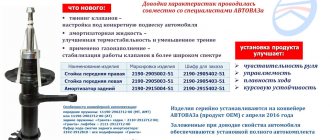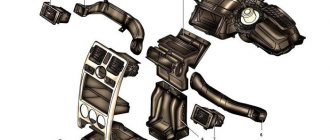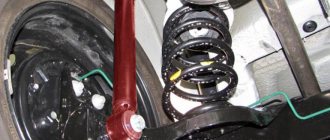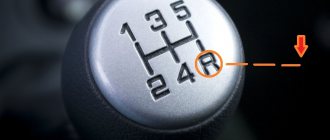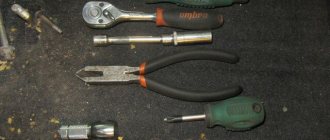Shock absorbers are key components of a car's suspension.
Without them, driving a car is not only uncomfortable, but also dangerous. The task of shock absorbers is to dampen the vibrations of springs that occur when driving on the road. In the absence of shock absorbers, it would take some time for the springs to “calm down” after the next bump; accordingly, at this moment the car would shake and sway. Such behavior of the car will quickly lead to dire consequences, for example, a breakdown of the muffler, underbody, damage to the suspension or an accident due to loss of controllability. One of the problems that can arise with shock absorbers is the appearance of smudges on them. If the shock absorbers are leaking, you can ride on them, but you should already think about replacing them.
What comes out of shock absorbers
To understand the question of why shock absorbers leak, you need to understand their design and operating principle. The shock absorbers themselves look like cylinders filled with liquid or gas. A piston with a rod is installed in them, and the element is sealed using rubber seals and gaskets.
During operation of the shock absorber, the piston and rod move through the mass inside the shock absorber. Since the travel is small due to the filling of the shock absorber and the tightness of the element, suspension vibrations can be damped, and only a small part of them is felt by drivers and passengers inside the car.
At the moment, oil, gas or mixed (in which there are separate chambers with oil and gas) shock absorbers are installed on cars. Only oil or mixed versions of the part can leak, and when gas escapes, the problem will be noticeable only by the “behavior” of the car.
Brief summary
We’ll repeat this probably for the fourth time – you shouldn’t drive on leaky struts. If you have ordered to live alone for a long time, then you need to change two on the same axis. This is more expedient and more profitable for the future. Usually, unless the shock absorbers are completely new, all four are changed at once. To preserve the suspension in general, and the struts in particular, for longer, check their condition regularly. After all, any malfunction noticed in time really saves money. This is a proven fact.
Source
Why do shock absorbers leak?
Gas or oil can escape from the cylinder if the seals are damaged. Rarely is the problem global in nature, and in most cases the oil leaks out of the shock absorbers slowly, leaving smudges that the driver can pay attention to, for example, when changing tires.
The reasons for damage to shock absorber seals are commonplace: the service life has reached the end, poor performance of the part or physical damage due to driving on bad roads.
Leaking shock absorber - causes and consequences
The shock absorber is one of the most important components of an automobile suspension.
In their absence, driving becomes not only irresponsible, but also dangerous. The main task of shock absorbers is to dampen spring vibrations that occur when driving on uneven or difficult roads. If there were no shock absorbers, the car would experience terrible shaking and vibration, since the spring would definitely take some time to return to its original position. At this point, the car will experience a strong degree of shaking. The result of such behavior of the machine may result in damage, such as a breakdown of the muffler or bottom, damage to suspension elements, or the creation of an emergency due to loss of controllability.
What can leak from the shock absorber? In order to find out the reason for the leakage of shock absorbers, it is worth carefully studying their design. The shock absorbers themselves have the form of cylinders filled with liquid or gas. A piston with a rod is installed in their inner part, passing through a mass located inside the element. Due to the fact that the stroke of the rod is not so large, due to the fullness of the shock absorber and the need to ensure the tightness of the element itself, it is possible to dampen suspension vibrations, and people in the cabin experience only a small part of them.
The main types of modern shock absorbers are oil, gas or mixed.
The reason shock absorber seals leak can only be due to age, end of life, or physical damage.
Is it possible to drive if the shock absorber is leaking?
A leaking shock absorber is a problem that requires a quick solution. It can lead to other malfunctions. The shock absorber must be replaced as soon as possible, but driving a car with a leaking element is not prohibited if you exercise extreme caution.
When one shock absorber leaks, it is necessary to replace it as quickly as possible so that the problem does not spread to the others. The fact is that the vibrations of the car are distributed between four shock absorbers. If one of them leaks and begins to cope with its assigned tasks worse, then the vibrations will have to be distributed among three shock absorbers, but they are not designed for such a load. Accordingly, if you do not change a leaking shock absorber for a long time, others will soon fail, that is, a massive replacement will be required, which is much more expensive.
When several shock absorbers leak at once, then it is better not to operate the car until they are replaced. If you need to use a car, it is better to choose smoother roads and drive extremely carefully. Without shock absorbers, it is impossible to enter a turn at high speed, and the car can not only skid, but also turn over. In addition, if vibration damping is poor, there is a high risk of damage to other parts of the car.
What to do and is it possible to drive?
Of course you can drive, in general you can “drive” without shock absorbers - but how? Of course, if you have one strut leaking, then you may not notice it, but if there are two at once, or as my friend had three (two in front and one in the back), then the car will “swing” like on a roller coaster. Even low speed and reaction to small irregularities caused the car to sway, I’m already silent about some sharp maneuvers (turns, for example), the car was simply drifting!
What to do - change it urgently , the sooner - the better, otherwise, due to your incorrect savings on racks - then you will pay more.
Is it possible to drive:
Guys, I understand that original shock absorbers are expensive, but they need to be changed! YES, and you can find quite sane originals, for example KAYABA, very sane quality and more or less prices.
What are the consequences if you don’t change leaking shock absorbers?
As noted above, failure of shock absorbers will lead to an uneven distribution of load between the remaining functional elements, which will affect their service life for the worse. In this case, the car will begin to seriously rock when driving, which will generally affect driving comfort.
If the driver is not afraid of the car swaying when driving on leaking shock absorbers, we can name a number of problems that a malfunction can lead to:
Impact to the bottom and damage to elements. For example, when overcoming a “speed bump” or a bump, a car on springs may jump and, when moving back, hit the bottom of an obstacle, which will lead to damage;- The occurrence of malfunctions in the suspension. If you drive a car with faulty or missing shock absorbers, over time there will be problems with silent blocks, bushings, ball and other suspension elements that risk failure. This happens because the vibrations of the car will have to be damped by all suspension elements;
- The car will stop “listening to the driver” on the roads. A car with faulty shock absorbers loses a lot in terms of maneuverability and controllability, which can lead to a traffic accident.
As soon as smudges appear on the shock absorber, it needs to be replaced. The part is still capable of working for several days/weeks, but after that it will completely cease to perform its functions.
( 438 votes, average: 4.53 out of 5)
Mud flaps for a car: installation, how to choose, why they are needed
Knock in the steering rack: how to remove it, causes, prevention
Related Posts
How to determine if shock absorbers are faulty
Car owners are not without reason concerned about the question of how to check an oil or gas-oil shock absorber. This is due to the fact that modern shock-absorbing devices often have a more complex design than older models, which makes diagnostic measures more complicated. Therefore, ideally, they should be checked in a car service center on a special stand. However, there are a number of “garage” verification methods.
Body rocking
The simplest, “old-fashioned” method is to rock the car body. In particular, they rock its front or rear part, or the shock absorbers separately. You need to swing it strongly, but do not bend the body elements (in practice, such cases occur!). In theory, you need to achieve the maximum possible swing amplitude, then release the body and look at its further vibrations.
If the shock absorber is working properly, the body will make one swing (or one and a half), after which it will calm down and remain in its original position. If the shock absorber has a malfunction, the body will make two or more oscillations. In this case, it must be replaced.
It is worth noting, however, that the rocking method is suitable for cars with a simple suspension system, for example, the VAZ “classic” (models from VAZ-2101 to VAZ-2107). Modern cars often use complex (often multi-link) suspension, so it will dampen the resulting vibrations even with faulty shock absorbers. Therefore, with the help of body rocking, by and large, it is possible to determine two borderline states - the damper is completely out of order, or it jams during operation. It is not easy to identify “average” states of a shock absorber using swinging.
Visual inspection
When diagnosing a problem shock absorber, be sure to perform a visual inspection. To do this, you need to drive the car into a viewing hole or lift it on a lift. You can, of course, dismantle the shock absorber, but this can take a lot of time and effort. During the inspection, be sure to check for oil smudges on the shock absorber body. You can wipe off traces of oil with a rag and leave it like that for several days. After this period, the test should be repeated.
If the car is raised on a lift, it is advisable to check the condition of the shock absorber rods. They should not show any signs of rust or damage. If they are present, then the device is at least partially faulty and additional diagnostics need to be performed.
When inspecting, be sure to pay attention to the wear pattern of the tires. Often, when shock absorbers are broken, they wear unevenly; as a rule, the main wear occurs on the inside of the tire. There may also be isolated bald spots of wear on the rubber. However, tread wear may also indicate other failures in the suspension elements, so additional diagnostics are also needed here.
If faults in the front shock absorber (strut) are checked, a mandatory inspection of the springs and upper supports must be performed. Shock-absorbing springs must be intact and free of cracks and mechanical damage.
Machine control check
If the shock absorber/shock absorbers are faulty, then while driving the driver will feel that the car is “scouring” along the road, that is, it will be necessary to constantly steer in order to keep it in the rut. When accelerating and braking, the car will sway. The situation is similar with lateral body tilts. In this case, it is not necessary to accelerate to a significant speed; the city speed limit is quite suitable for testing. In particular, at a speed of 50...60 km/h you can do sharp acceleration, braking, and snake.
Indirect signs of malfunction
To see that the shock absorber strut is leaking, just look at the suspension from below. However, it is not always possible to do this. And on some cars, due to the design of the shock absorbers, they are simply not completely visible. Accordingly, it will be useful to know about indirect signs that the rack is leaking.
This includes the following signals:
- long rocking of the car even on a flat road;
- knocking when driving over uneven surfaces;
- beating in the steering wheel;
- severe body roll when accelerating, braking or maneuvering.
This is more difficult to notice, but when shock absorbers leak, fuel consumption and braking distance increase, the car handles worse, and does not hold the road during aggressive driving.
